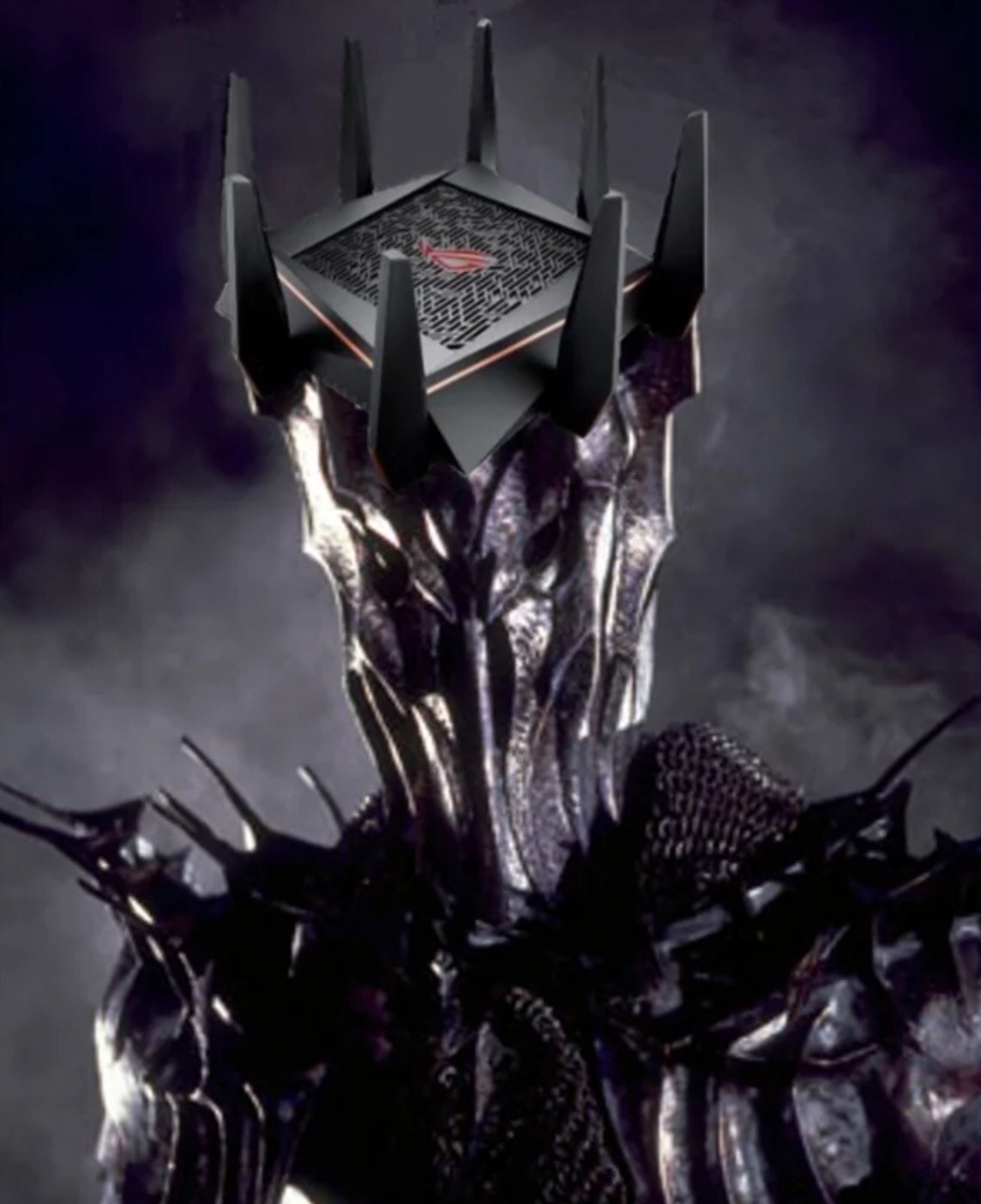Does this ridiculous number of antennas even do anything or is it just marketing wank?
Technically, it does provide better connection speeds by enabling the router to avoid channel hopping, so it can talk to multiple devices (or the same devices if it has multiple antennae) at the same time. This is part of the recent wifi6 and wifi7 standards so more and more devices will start to gain speeds using this technique
Realistically computers have at best 2 antennae and this is largely marketing wank.
Though if you have multiple devices all trying to connect to wifi, like even a phone for example, then a computer having two antenna that it can actually use 100% of the time still sounds valuable to me.
Lookup “phased array” and “beam forming”
Sure, but this isn’t that. That requires actual work put in developing and simulating the product, these are just multiple antennae for multiple channels.
Source:
trust me broI work in semiconductors at a firm that creates RF chipsI mean, beam forming is a pretty common feature of these routers.
No one should trust you if you don’t know that since .ac we have had beam forming and it got better in .ax
This router pictured is a ROG Rapture GT-AX11000 Pro that has .ax
Lord Sauron would like a word.

It does. Wifi uses MIMO (Multi-in, multi-out) to run multiple concurrent data streams over the same channel width, which overcomes individual channel bandwidth limitations (there’s only so much radio frequency space to go around). Each stream having its own antenna, and having larger antennas, gives stronger signal/noise ratios, less retransmitted packets, and overall better connections.
A lot of those high end “gaming” routers are often oversold though… MIMO improves throughput if you have an Internet link it can saturate; realistically even a midrange 2x2 802.11AC router will provide more wifi bandwidth than your internet does. And for gaming, they do nothing to improve latency no matter how many streams you run, as wifi’s inherent delay (5-15ms) is pretty much a fixed quantity due to its radio broadcast time-sharing nature. The meme is correct. A $6 ethernet cable beats any and all wifi routers and client adapters, and always will.
To be more precise it’s not each stream having it’s own antenna, you combine the signals from all antennas and then “spatially filter” it into separate streams, but the number of concurrent streams is limited by the minimum of the number of antennas at both ends of the connection, if your device has only one antenna and your access point has eight you can only have one data stream.
MIMO improves throughput if you have an Internet link it can saturate; realistically even a midrange 2x2 802.11AC router will provide more wifi bandwidth than your internet does.
And that’s where the fat controller says you are wrong. I have 1000 Mbps down. I’ve yet to actually hit that speed with WiFi 6.
Also newer WiFi standards significantly improve latency. That’s nothing to do with having more antennas though you would be correct there.
The meme is correct. A $6 ethernet cable beats any and all wifi routers and client adapters, and always will.
With current technology you would be correct. But as for the always part: Ethernet is an electrical signal, so it’s actually slower than microwave signals used by WiFi, and the WiFi signals can also take a more direct path. So in the future WiFi or LiFi could in fact be faster. It’s the processing delay, and scheduling that makes WiFi have higher latency. Not the physical medium.
Before you say this is all academic because of the small distances involved I would remind you that propagation delay is actually a large issue in current microelectronics and computers. Sometimes parts of the same chip are far enough apart to create problems for the engineers due to the high clockspeeds of modern devices.
What fast of a WAN connection are you talking about?
I can’t see how a midrange 802.11AC AP could suffice for a decent WAN connection. IMO you need at least 802.11ax
2x2 AC on 5ghz has an 867mbps max PHY throughput, which after a 50% derate for signal quality and overhead is still a very comfortable 400mbps… typical cable internet is around 100 to 500mbps with a lot of places offering “1gbps” that it never actually reaches, so it’s certainly sufficient for 90% of people.
If you have a very heavy multi user (6+ devices always on) household you may find some benefit from an AX 2x2 or 3x3 router just because it can handle congestion better.
It’s not all about the WAN speed. Having fast LAN speeds is always worth it.
This will help hugely with stuff like PC game streaming (from your PC to a tablet or TV for example), screen sharing to TV, file transfers over LAN, media servers, etc.
You won’t ever get anywhere close to that though on 2x2 AC.
Where do you live where 1 Gbit/s is much lower than 1 GBit/s? When I had 1 GBit/s, I got around 800-950 Mbit/s. When I had 2 Gbit/s I got around 1,7-2,5 Gbit/s
What do you define as a “decent” WAN connection?
I’m a network professional with a specialty in wireless.
Yeah, beam forming and mimo are the main reasons for antenna diversity. There’s also more radio chains in those units typically, and more radio chains can provide better speeds if you have client devices that can take advantage of the extra radio chains (both sides need to have the same, increased number of radio chains to see an increase).
The antennas are fairly small/thin pieces of wire that are not very long, so the antennas don’t need to look like that, but the quantity is useful.
As someone with a telecommunications background who’s taken apart some cheap routers that look like that: the only caveat I’ll add is that the antennas are only useful if they’re actually connected to anything. From a decently trustworthy brand you’re probably fine, but I’ve seen a few where only one or two of the antenna couplings were connected to anything internally.
There’s no shortage of liars and cheats everywhere. I’m unsurprised that a company world either intentionally, or through sheer ignorance, have “antennas” that are little more than aesthetic pieces of plastic.
I believe it’s for beam forming which can be used to improve signal strength in a specific direction.
Some of them are marketing wank, some of them have MIMO channels that need multiple antennas to support independent bands with multiple devices.
1 MIMO channel = 2 antennas, so this router could theoretically have 4 devices communicating bilaterally without interrupting each other.
deleted by creator
Hay $800 worth of copper, I found a 1000ft roll of shielded pure copper for $2.11 because someone misplaced the decimal point I know because it was listed for $2.1199 every thing was automated through amazon so they just shipped free shipping to, thank for listening $800 worth of copper, your the best.
deleted by creator
My PC, laptop, work laptop, are all wired using gigabit. But my laptop on wifi reach 1200Mbps so it’s faster than cable!
Faster than gigabit, but not 2.5 gigabit. Your cables likely support the speed, just your ports and switching hardware are capped at gigabit.
It’s not extremely expensive, but unless you move around a lot of big files, you’re probably getting very diminished returns, even spending less than twice as much for 2.5x speeds.
Impressive, I lose half my speed with the router around the corner.
If you have only one device on Wi-Fi, multiplexing turned off, or especially if you have MU-MIMO support, Wi-Fi can be faster than a single wired connection. It is still higher latency and subject to other drawbacks such as security and power consumption, but of course it offers advantages that can outweigh the disadvantages depending on use case and user needs.
That said, it’s technically not faster than the cable, but rather faster at the data link or network layer. For example, CAT8 physically supports up to 40Gbps, but most consumer and even professional electronics only support up to 2.5Gbps. Only really enterprise level switches can push up to like 100Gbps onto copper, and even then that’s using QSFP transceivers, not RJ-45 connections. Fiber cables regularly push 400Gbps.
Same lol. I get 800Mbps on Cat6, but 1100 on Wifi 6 with one of these fancy expensive 11000ax gaming routers that has all those antennas (antennae?).
*Excluding running ethernet cables to every room through the attic, down the walls to wall jacks. Also the cost of the jacks, and the various switches needed for several rooms. And the contractor to do it all.
But hey for like $600 I have cat6a in basically every room so
And the contractor to do it all.
Why wouldn’t you do it yourself?
Disabled, so physically cannot do it, or I would.
Like, in an old house its a massive pain in the ass to run that, but still firmly in DIY territory.
Not everyone is comfortable drilling walls and installing plates, stripping wires, etc. and CAT cables aren’t like simple copper electrical wires.
And not everyone wants to have cables running along their floorboard and up their stairs
I’ve looked into wiring decent Ethernet through our walls, where the phone lines are. Wooden flooring isn’t very common here so pulling through the wall ducts that have dodgy AC cables and Cat-negative-1 telephone “cables” is the only realistic option. Personally I even think I’d like to run double Ethernet cables anywhere just so I can have flexibility. When I get my own place someday, the cable duct provisioning will be absolutely ridiculous, I’ve already promised myself.
The ducts are complete trash and it’s a miracle the phone lines even worked for so long. Our electricity is so goddamn noisy here that any Ethernet signal would be affected, meaning I’ll definitely need better cables and end up with worse speeds. So noisy that powerline Ethernet really sounds like a punchline. The WiFi isn’t great because the only place the AP/router has access to the phone line is right where it enters the apartment, which is from the elevator shaft - meaning a giant Faraday cage shields half the apartment from the WiFi. We’ve disconnected the phone lines in the walls because those are completely fried and have started to introduce so much noise that it’s audible on the landline and completely kills any synchronization with the phone center. Like it’s fucking bad. All that headache for 2-4 megabit unreliable DSL. Even for Lebanon, the perennially cursed paradise we call home, pretty goddamn bad.
I’ve looked into coax Ethernet, the problem is that every few years a bolt of lightning hits the TV cable network in my neighborhood and deep fries every TV that wasn’t manually disconnected at the start of the storm. Just awful. I suspect the cable integrity is better throughout the walls though. A lot of splitters though.
The best part? I live in a part of my cursed country where they’ve started connecting FTTH. And for some reason they stopped laying the cables mere meters from my building in like 2020 and just never bothered to keep going. And the fiber company has legitimately blocked every phone number I’ve since inquired from. I’m not joking when I say I’ve considered just suspending a thick thick optic (remember the lightning, there’s no grounding here!) SFP cable along the municipal power poles (let’s not discuss legality here, it’s okay, this is Lebanon habibi), putting a nice switch in a neighbor’s house, and just paying for their internet in return for making sure that one port is nice and snug.
I do think my best bet is (when the fiber finally arrives in 2097) some kind of mesh WiFi with no backhaul, or some kind of Ethernet backhaul that relies on routing the meatiest Ethernet cable I could find on the outside of the building.
Another alternative is paying out the absolute ass for a corporate Internet subscription, but microwave internet is susceptible to the weather, and the whole thing is just so much upfront cost that it can’t be worth it. Although maybe going that route five years ago would have been worth it.
Just awful. At least everyone’s on Netflix and short form video now so data caps have moved past the pathetic 20 and 30 GBs they were only a decade ago.
Counterpoint: I’ve probably saved a significant amount of money by having the odds overwhelmingly stacked against me setting off on my homelab journey. lol
Oh god that sounds frustrating AF.
And then you still need a wireless router to get Internet on your phone unless you use data at home like a crazy person.
USB-C > Ethernet dongle like a true Network Master.
But what if you’re gaming downstairs and the router is upstairs and then you have to go upstairs for pizza rolls so you take your gaming laptop upstairs and you’re eating right next to the router and so you’re just plugged in and then what if you forgot to turn off the oven and your girlfriend is yelling at you “You’re going to start a fire! Why can’t you remember to turn off the oven? What’s wrong with you?” and then you go back downstairs to finish gaming?
I use the microwave for my pizza rolls like a savage. Problem solved.
I eat my pizza rolls cold, like a savage
If that happens often enough to be worth 43 times more than the cat cable, then it sounds totally justified to me. But also, what if you got a toaster oven for upstairs? To put next to the router?
What if you used the router as the toaster oven? Tapping_head.gif
Let’s see that ethernet cable do orthogonal frequency-division multiplexing…
Wireless tech has improved greatly over the last 20 years. Speed, latency, bandwidth, stability…all generally excellent. 15 years ago I wouldn’t have wanted to use a wireless mouse or LAN connection. Now? NBD. They just work. Still have issues with poor signal in some areas, but mesh range boosters take care of that pretty easily.
Wireless peripheral devices, sure, but if I’m streaming 4K with HD sound then I still want copper.
Even shitty wireless will let you stream 4k. It only takes 50mbps. 802.11g came out in 2003 and can do 54mbps.
Shitty wireless lets you stream shitty 4K. Yay? Copper is still king for anything that’s not a goddamn webrip.
Wtf dude, that was the example you provided, and then you mocked it. Make up your mind.
If it was a shitty example, why did you use it?What would be a good example of things people commonly want and have access to but that wireless cant do?
They’re saying 50Mbps 4k is shitty, not that 4k is a bad example. Modern Wi-Fi can definitely handle high-bitrate video 99% of the time, but that 1% where someone turns on a microwave can cause hella buffering. If you have the ability to run ethernet there’s no benefit to using Wi-Fi.
Seriously, I was going to add my WiFi6e is theoretically way overkill for my limited usage and that’s supported by speed tests, yet I do notice its limitations while gaming. It’s got the bandwidth, it’s even got the low latency, but it also has the glitches. Until that speed is reliable enough to never impact my games, it’s not worth being my first choice
Even then, wired is better where appropriate because it just works. The more devices I can put on Ethernet, the fewer require the extra setup of wifi, the extra risks to eavesdropping and single points of failure, and yes the fewer where I ever have the frustration of glitches
Why are you limited to 50Mbps 4k, if not limited by the server? I haven’t had an issue with microwaves in like a decade. Maybe it’s an issue for people with bachelor apartments where their router and microwave are on the same table?
Get reliable connection ?
What do you consider a reliable connection?
I just tested my connection to my ISP on my wireless gaming computer, and I got:
2ms ping
0ms jitter
0% packet loss
With >500mbps down
And almost those same numbers from my phone in the next room.So what do you consider the qualifications for “reliable” connect, if that doesn’t meet them?
The fact that you don’t have to worry about Wifi suddenly getting weak for one
50mbps is a fuckterrible bitrate for 4k HDR video content.
You should be playing physical media anyway, though.
I’m seriously thinking of getting a usbC-ethernet dongle for my mobile, for when I’m at my desk.
If you have wireless charging then you should definitely get the dongle. I have one for those times I need stability. Get a thin lightweight USB C extender so the dongle is not getting in the way.
Getting a USB dock instead would probably get you both charging and Ethernet.
I have one that has hdmi and usb as well so I can use my phone in desktop mode on a monitor, then I use parsec to get in my VM and I have access to a full desktop experience
Nice!
For others considering this, keep in mind that not all phones support external monitors, they need specific hardware for it. Pretty much all Samsung S phones support it, Pixels do not. So check if your phone supports external displays before you buy any hardware!
Google added external monitor support starting with the Pixel 8. So, yeah… Most don’t support it, but newer ones do!
Can you not charge and use a single USB-C port at the same time?
Yes you can. You just need a dock instead.
I mean I just have more than one port and can charge using the dedicated charging port.
What laptop are you using that makes it such an affair to use two USB-C ports?
Edit: I missed the “mobile” part
If I’m reading the thread correctly, they’re referring to a mobile phone which only has 1 USB port typically
Ah butts, you’re right, the first guy said “mobile” and I didn’t read it correctly. I can’t figure why they would ever need a connection like that for their phone, though.
I, too, have shitty wireless. In fact, for my work laptop, that’s exactly what I do. So much more reliable. Way too many wireless connections on too many channels close by.
Wireless data links should be the exclusive domain of temporary, nomadic and/or sacrificial applications.
If the channel is permanent, static, or critical; as much of the path as practicable should be provisioned with constrained energy transmission.
Would be cool if building code standards included Cat5 (or even better, USB) along with the standard power and phone connections of new builds.
I spend a lot more money on good Ethernet switches. But at least that works and is easier to manage than Wifi.
Yeah this kinda overlooks a lot of the issues with like… getting a cable somewhere
My house is relatively new (built 2005), and they pulled cat5 for all the telephone lines and just didn’t hook up the extra pairs of wires. Since nobody uses landlines anymore, I rewired most of the outlets for RJ45.
Have pulled a few more wires, including fiber to my main office PC (so I can have a very fast connection to my NAS). Once you learn a few techniques and the way your building is laid out, it’s not that hard.
Yeah, you got to skip over the “getting the wire there” part. If you wanted to replace all that line with cat 5e or cat6 so you can get full duplex gigabit speeds it’d be a much harder task than slapping some rj-45 end onto some old cat 5.
Curve ball… I use power line and for my property and in my use case it is not any different to ethernet.
EoP is really cool
$6.99/5’ of cable. A weekend of manual labor running cable through my walls.
Or $300 for something I can set-and-forget.
Decisions, decisions.
$300 in labor is wildly optimistic and true for a simple cable run, maybe
If run probably even a “short” run will typically be at least 20ft. Think, from a wall plate, up an 8ft wall, across a crawl space, down another 8ft wall.
Not all cable runs are simple
It doesn’t even cost that much for a decent wifi AP either.
I got a used 10Gbe switch and a thunderbolt 10Gbe adapter for my computer and now I can transfer my videos and photos from my NAS like it’s my internal hard drives.
It can also do 2.5Gbe which pretty much future proofs me.
Phased arrays are not a joke. You can get ridiculous dynamic range with those
Unless you need 6ft of cable or you just run wires on the floor it’s more like $200 of plenium rated cable, and keystone jacks and the labor involved with the run.
My house with a half finished basement (easy access) took probably 16-20 hours running to 5 rooms.
Nah, wifi is pretty good today. I just dont like the consumer devices like the router shown here. Recently redid my wireless and went with a non wifi router, a poe switch and a few access points, connected through ethernet. I wouldnt dream of going back to the conventional one wifi router. Still use wired for stationary devices I can reach with a cable though… TV, AV, consoles, PC are all wired.
To be honest, I think a lot of Lemmy users are old and yearn for the older technologies simply because they have been more familiar with them than newer ones. They would have used the first gen of a technology, which may not be efficient, and dismiss it altogether, without realising that subsequent generations of that technology improves over time.
I have had that realisation of cognitive bias when I had Bluetooth headphones back in early 2010s. The wireless connection isn’t great and gets cut off every now and then. I dismissed the technology as less efficient than wired earphones. It was over the years with the popularity of airpods that I gave wireless earphones another chance. And honestly, the Bluetooth connectivity vastly improved than I expected and I would not go back to using wired earphones again on regular basis because I don’t have to deal with the wires getting tangled or yanked. I only use wired ones as backup if my wireless earphones went missing or broke.
Sorry to say this to OP, but it seems that you’re being an old man yelling at the clouds. Look, I’m also old and I admit I have had that moment of yelling at the clouds too. We will have that more moments as we age.
I have a similar setup to @PieMePlenty@lemmy.world in regards to my home network and I wouldn’t dream of removing my wifi network. I still consider wired to be superior though it rarely matters at those latencies.
My Windows laptop on wifi:

My Fedora on wired network:

Wifi 7 is insanely fast to the point where it can easily be just as good as wired ethernet and can even beat a lot of the wired standards except the few latest ones. It’s a good choice for devices where running a cable wouldn’t be very practical, but you need wired level speed and reliability.
wired level speed and
reliability.While WiFi is a lot better nowadays I’ve never seen it reach the reliability of wired networks.
wired will always be better, faster, more reliable, and cheaper















